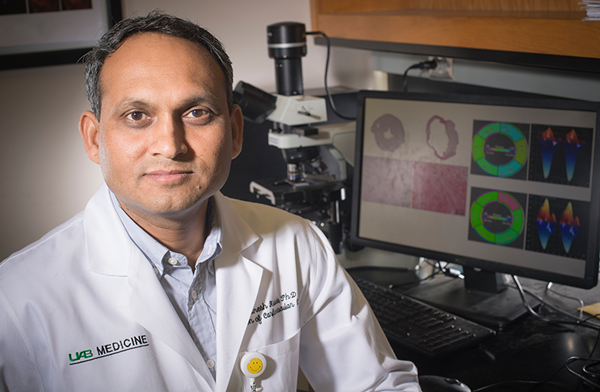
 Ganesh Halade, Ph.D., assistant professor in the UAB Department of Medicine, is the second winner of the School of Medicine’s Featured Discovery, an initiative designed to celebrate important research from School of Medicine faculty members. He conducted research that shows how the spleen’s immune response plays a leading role in the cardiac healing after a heart attack. Read more from UAB News here.
Ganesh Halade, Ph.D., assistant professor in the UAB Department of Medicine, is the second winner of the School of Medicine’s Featured Discovery, an initiative designed to celebrate important research from School of Medicine faculty members. He conducted research that shows how the spleen’s immune response plays a leading role in the cardiac healing after a heart attack. Read more from UAB News here.
The School of Medicine communications staff sat down with Dr. Halade to get his insights about his research, UAB and the science community.
Q: What compelled you to pursue this research?
A: To define inflammation and resolution processes in heart failure, we asked the key question: When does resolution, which allows healing, begin after a heart attack? We know that after cardiac injury—just like any kind of wound healing process—inflammation is the first response of essential physiology, but the resolution of inflammation was unclear in heart failure. For this, we attempted to learn from mouse cardiac healing using a comprehensive and integrative approach. We quantitated specialized resolution biomolecules in the mouse-injured heart that are identical between the mice and humans. Overall, the compelling questions, when and how does resolution begin, directed our team to pursue this research.
Q: What was your most unexpected finding?
A: We discovered two unexpected findings. First, the resolution of inflammation begins immediately with the onset of inflammation that confirms resolution is an active process and essential for cardiac healing. Second, an injured heart gives a signal to the spleen that amplifies resolution biomolecules to facilitate cardiac healing.
Q: How do you feel your research will impact the science community?
A: The presented discovery will advance the heart failure field, because we distinguished inflammation and resolution biomolecules that could be used for diagnostic or personalized perspective due to resemblance of bioactives between mice and human. Thus, our discovery is exceptionally transformative and useful to develop novel strategies to diagnose or treat heart failure.
Q: What is your research’s relevance to human disease?
A: This development in resolution of the inflammation area is translational and applicable to many cardiovascular disease pathology, including atherosclerosis and vascular remodeling. It could apply to other more common chronic inflammatory diseases with a diagnostic and precise approach. We are examining the mechanism of individual bioactive or it in combination with current drug therapy in basic research. This will build the foundation for future clinical studies.
Q: What made you come to UAB?
A: I came as an early career faculty because of the strength of the UAB cardiometabolic investigators across the different divisions and departments. The leadership has been extremely helpful and supportive, allowing me to build a mouse cardiovascular core in the Comprehensive Cardiovascular Center within the Division of Cardiovascular Disease.